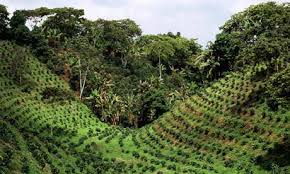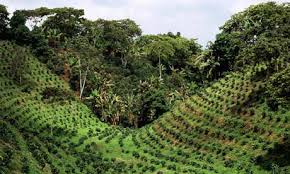
A different form of attention is being accorded to coffee plantations that are grown on the slopes of the Sierra Maestra Mountains in Cuba. The place lies about 500 meters above sea level.
The Santiago de Cuba wants to make the coffee plantations a tourist attraction and for this purpose, since 20-154, it has bene promoting the Coffee Roads project. The French settler has arrived at this spot about 200 years ago and the long coffee tradition in these mountains is aimed to be taken advantage of by the city authorities.
Archaeologist Yumara Lopez, coordinator of the project, said that the values of the local coffee culture are intended to be promoted and disseminated and for this purpose the Coffee Road will be a catalyst.
The French had continued with their culture of planting and harvesting of the coffee bean and had created more than 600 farms in the eastern mountains after they were forced to flee from Saint Domingue, now Haiti, by the triumph of the slave rebellion.
"The mountains surrounding the city were rapidly populated with coffee plantations and their production was a driving force of local development," said Lopez, without hiding her passion for the topic.
And as wealth came in by the process, the face of the city was changed, Lopez pointed out.
The location of about 170 of the coffee plantations have been identified by the city's department of archaeology, led by Lopez, even though there is very little remaining of the coffee farms today.
These agricultural emporiums form the "Archaeological Landscape of the First Coffee Plantations in Southeast Cuba," which was declared by the United Nations Educational Scientific and Cultural Organization as World Heritage of Humanity in 2000.
La Isabelica is a far in that area and it has been transformed into a unique museum that details the coffee tradition and the French cultural heritage prevalent in the area and La Fraternidad, another coffee plantation, is currently being restored. These are two of the more important of such farms.
"The aim is to promote these cultural spaces and manage them so the associated communities could receive practically immediate economic benefits," said Lopez.
The Dranguet House is another potential point of interest and was created between 1859 and 1861 by a landowner descendent of the French settlers who had fled Haiti to seek asylum in Cuba.
Apart from housing the Center for Interpretation and Dissemination of the Coffee Cultural Heritage, also the headquarters of the project is Casa Dranguet, which is located just one block from the central Cespedes Park.
In addition of playing a central role in the society b organizing cultural events, it is also engage din the sale of coffee even as it owns a peculiar museum and its scientific work.
The essence of the Coffee Road project is created by the continuous smell of coffee that is infused with the locale blends suing both art and science.
(Source:news.xinhuanet.com)
The Santiago de Cuba wants to make the coffee plantations a tourist attraction and for this purpose, since 20-154, it has bene promoting the Coffee Roads project. The French settler has arrived at this spot about 200 years ago and the long coffee tradition in these mountains is aimed to be taken advantage of by the city authorities.
Archaeologist Yumara Lopez, coordinator of the project, said that the values of the local coffee culture are intended to be promoted and disseminated and for this purpose the Coffee Road will be a catalyst.
The French had continued with their culture of planting and harvesting of the coffee bean and had created more than 600 farms in the eastern mountains after they were forced to flee from Saint Domingue, now Haiti, by the triumph of the slave rebellion.
"The mountains surrounding the city were rapidly populated with coffee plantations and their production was a driving force of local development," said Lopez, without hiding her passion for the topic.
And as wealth came in by the process, the face of the city was changed, Lopez pointed out.
The location of about 170 of the coffee plantations have been identified by the city's department of archaeology, led by Lopez, even though there is very little remaining of the coffee farms today.
These agricultural emporiums form the "Archaeological Landscape of the First Coffee Plantations in Southeast Cuba," which was declared by the United Nations Educational Scientific and Cultural Organization as World Heritage of Humanity in 2000.
La Isabelica is a far in that area and it has been transformed into a unique museum that details the coffee tradition and the French cultural heritage prevalent in the area and La Fraternidad, another coffee plantation, is currently being restored. These are two of the more important of such farms.
"The aim is to promote these cultural spaces and manage them so the associated communities could receive practically immediate economic benefits," said Lopez.
The Dranguet House is another potential point of interest and was created between 1859 and 1861 by a landowner descendent of the French settlers who had fled Haiti to seek asylum in Cuba.
Apart from housing the Center for Interpretation and Dissemination of the Coffee Cultural Heritage, also the headquarters of the project is Casa Dranguet, which is located just one block from the central Cespedes Park.
In addition of playing a central role in the society b organizing cultural events, it is also engage din the sale of coffee even as it owns a peculiar museum and its scientific work.
The essence of the Coffee Road project is created by the continuous smell of coffee that is infused with the locale blends suing both art and science.
(Source:news.xinhuanet.com)














